
James Webb's Amazing Discoveries
Cat: SCI
Pub: 2023
#2303b
Insane Curiosity 2023/03/01
23417u
Python Sympy Code
Remarks
>Top 0. Introduction:
- Hey, let mi introduce myself. My name is James Webb and I'm an explorer. I'm here to share with you some of the incredible and images I've stumbles across through my travels. From galaxies million of light years away, to supernovae that can't be seen by the human eye, I've seen it all! Let me take you on a journey through the universe and show you the most amazing sights imaginable. Let's go!
- Re: JWST's instruments aboard:
- NIRCam (Near-InfraRed Camera): 0.6-5μm wavelength
- NIRSpec (Near-Infrared Spectrograph): measuring NI specturm of up to 100 objects like stars or galaxies.
- MIRI (Mid-Infrared Instrument): camera and spectrograph sees light in MI region (5-28 μm)
- FGS-NIRISS (Fine Guidance Sensor & NI Imager and Slitless Spectrograph): observes light from 0.8-5.0 μm
0. 序文:
- NASA/ESAが中心になって2021/12/25に打ち上げられたHubble宇宙望遠鏡の後継機である。James Webbは、NASA長官を努め (1961-68)、アポロ計画など米国の宇宙開発を主導した。JWSTは、太陽地球系のLagrangian point L2 (太陽の反対側150万Km、月の公転軌道の約倍)を飛行する。
- 機体は50K以下の極低温に冷却。NASAは、機器の設計開発に88億ドル、運用に8.6億ドル、ESAの拠出金額は7億ユーロ、CSAは2億カナダドル。
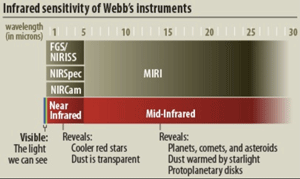
- 搭載機器
- NIRCam 近赤外線カメラ
- NIRSpec 近赤外線分光器
- MIRI 中赤外線観測装置
- FGS-NIRISS 近赤外線撮影・連続波長分光分析計
>Top 1. Volans: Galaxy Cluster SMACS 0723:
- Deepest infrared view of the universe to date:
- The first thing Webb did was to provide astronomers with the most in-depth and sharpest infrared view of the far-flung universe yet. Its first deep field, the galaxy cluster SMACS 0723, is full of thousands of galaxies, including the faintest objects ever observed in infrared. The telescope captured this image, which is approximately the size of a grain of sand held out at arm 's length, of an incredibly small area of the vast universe.
- The combined mass of the galaxy cluster acts as a magnifying lens that amplifies more distant galaxies, some of which were seen when the universe was only a billion years old. This deep field, obtained from images taken from various wavelengths, took Webb's Near-Infrared Camera (NIRCam) 12.5 hours to take- surpossing the longest time Hubble Space Telescope took to obtain its deepest field. Suck it Hubble! Now let's talk science!
- This image displays the galaxy cluster SMACS 0723 from 4.6 billion years ago, with many galaxies in front and behind the cluster. Researchers will be able to break down and analyze Webb's data to learn more about this cluster. Additionally, Webb's Mid-Infrared Instrument (MIRI) also witnessed this field, observing mid-infrared light. Webb's NIRCam has produced the most detailed look at galaxies ever seen before, including their faint features like star clusters and diffused areas. The light coming from these galaxies has been travelling for billions of years before reaching us and going back to the time of the big bang. The wavelength of the visible light has been sifted to infrared, which Webb is designed to observe.
- After analyzing the data, researchers will be able to gain additional details like the galaxies' mass, age, origin, and components. The prominent arcs withing the field is also seen. This is because the galaxy cluster's powerful gravitational pull is bending the light from more distant galaxies behind it, like a magnifying glass distorting an image. Stars are also witnessed, appearing brighter with noticeable diffraction spikes at shorter wavelengths.
- Webb's MIRI image provides a colorful and vivid image of the dust clouds - essential for star formation and life itself - with blue galaxies having fewer dust particles, red galaxies being overwhelmed with dust, and green galaxies having a mix of hydrocarbons and other elements. Very colorful and beautiful, I am in awe! If this was only Webb's first picture, can you imagine how great the rest is going to be?
1. とびうお座: SMACS 0723銀河団:
- SMACS 0723:
- とびうお座(Volans)の方向の銀河団 (46億光年先)
- これまでで最も鮮明が赤外線での画像。深部宇宙の銀河団を探索。この領域は、腕を広げた時の砂粒ほどである。
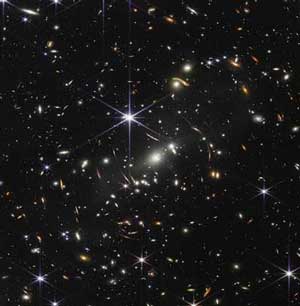
- この銀河団は、ビッグバン後10億年ほどに形成された初期銀河である。この画像は、JWSTの近赤外線カメラ(NIRCam)で12.5時間かかって合成された
- この銀河団の前後には多くの銀河がある。これらの銀河からの光は、長期間の移動の間に可視光の波長は、赤外線にシフトした。
- データ分析の結果、銀河の質量、年齢、起源、成分など追加の情報を得ることができた。
- また顕著な弧は、背後にあるより遠くからの銀河の光を重力レンズの効果で歪めている。
- 恒星もよく観測されており、短波長で謙虚な回折スパイクが見られより明るく見える。
- 青い銀河はダスト粒子が少なく、赤い銀河はダストが多い。緑の銀河は炭化水素と他元素との混合物を含む。それぞれがカラフルで美しい。
Two Arcs Are the Same Galaxy
- Let's go on an intergalactic treasure hunt with the NASA/ESA Webb Telescope! (NIRISS Emission Spectra)
- The near-infrared image of galaxy cluster SMACS 0723 reveals a group of massive galaxies below and to the right of the bright central star with numerous distorted and magnified galaxies.
- Upon inspection, one arc appears to be composed of two similar-looking galaxies. Are they the same? Spectra from the Near-Infrared Imager and Slitless Spectrograph (NIRISS) helps researchers answer this. By plotting the spectra from each of the two galaxies, the graphs match which suggests that the arcs are identical and both were emitted 9.3 billion years ago.
- NIRISS' ability to spread out the spectra reveals which lines match which source. Who knows what discoveries awaits as researchers us NIRISS to turn every object's image into spectra? Let us know what your guesses are!
- Very Early Universe: (NIRSpec MSA Emission Spectra)
- ADD PHOTO
Using the Near-Infrared Spectrograph's (NIRSpec) microshutter array, the Webb has made another incredible discovery, it never stops, does it? This instrument has over 248,000 small doors, each of which can be opened to measure light from up to 50 separate objects at once.
- By looking at the 48 galaxies in the background of the galaxy cluster SMACS 0723, researchers were able to see distant galaxies in the early Universe, estimated to be 1.3 billion years old.
- These spectra prove useful in that they show a pattern of three lines in the same order - one hydrogen line, followed by two ionized oxygen lines - which gives a measure of each galaxy's redshift and, therefore, how long ago the light was emitted. The farthest galaxy observed was determined to be 13.1 billion years old, which is believed to be the first time these emission lines were seen at such a large distance.
- It is also believed that there may be more distant galaxies hiding within this image. Using Webb's data, astronomers can pinpoint the distance, temperature, gas density and chemical composition of each observed galaxy.
- On top of that, Webb provides high-resolution near-infrared light information, far from the filtering of Earth's atmosphere. Comparing these spectra with those of nearer galaxies observed by both ground- and space-based observatories, scientists can understand how galaxies have changed over billions of years, beginning at the early Universe.
2つのアークは同じ銀河:
- 銀河間の宝探し:
- SMACS 0723の近赤外線画像は、明るい中央の星の下と、右側に歪んだ多数の大質量銀河群を映し出した。
- 一つの弧が、似たような形の2つの銀河で構成されているように見える。近赤外線撮影装置(NIRISS)のスペクトルは一致したので、この弧は同一で、どちrも93億年前に放射されたものである。
- NIRISSは、スペクトルを広げることができるので、どの線がどの天体から出たものかがわかるのである。
- 初期宇宙:
- 近赤外線分光器 (NIRSpec)のマイクロシャッターアレイを使った驚くべき発見があった。この装置には248,000以上の小さな扉があり、それぞれの扉を開けることで、最大50個の別々の天体からの光を一度に測定可能。
- 銀河団SMACS 0723の背景にある48個の銀河を見ることで、研究者はBig Bang後13億年後の初期宇宙でできた遠方の銀河を見ることができた。
- これらのスペクトルは、水素線が1本、イオン化した酸素線が2本というい3本の線が同じ順序で並ぶパターンを示すことから、各銀河の赤方偏移、即ち光を放出した時間を知ることができる。この結果、最も通り銀河は131億年前のものであることが判明し、このような遠距離からの発光線が観察されたのは初めてである。
- またこの画像の中には、もっと遠方の銀河が隠れている可能性もあり得る。Webbのデータによって、各銀河までの距離、温度、ガス密度、化学組成をピンポイントで特定することができる
- またWebbは、地球大気のフィルターにかからない高解像度の近赤外線情報が得られる。これらのスペクトルを、地上や地上や宇宙で観測された銀河のスペクトルと比較することで、宇宙初期から数十億年の間に、銀河がどのように変化してきたから理解することができる
>Top 2. Phoenix: Exoplanet WASP-96b:
- Exoplanet WASP-96b:
- The atmosphere of WASP-96b analyzed by the James Webb Space Telescope. Using its advanced design, NASA's JWST has recorded the distinct signature of water and evidence of clouds and haze in the atmosphere of an orbiting puffy, hot gas giant around a distant star similar to our Sun. This is the most detailed observation of its kind to date and is a major milestone in the search to identify habitable planets beyond Earth.
- This exoplanet, named WASP-96b, located 1,150 ly away in the constellation Phoenix, has a mass lower than half of Jupiter's and is much puffier than any planet in our Solar System. Its temperature is over 1000ºF (538ºC) and it completes an orbital period of just 3.5 days around its star. This combination of factors makes WASP-96b an ideal target for atmospheric investigation.
- On June 21, Webb's Near-Infrared Imager and Slitless Spectrograph (NIRISS) captured a light curve showing the overall dimming of starlight during the transit, and a transmission spectrum showing the brightness decrement of infrared wavelengths between 0.6 and 2.8 microns. Analysis of the spectrum showed the presence of water, haze, and clouds, which was unexpected from prior observations.
- The Webb telescope was able to detect color differences of a thousandth of a micron and brightness variations of a few hundred parts per million. These observation demonstrates Webb's extraordinary capabilities for exoplanet research.
- In the coming year, its spectroscopy will be used to survey several dozen planets from rocky worlds to giants, with a quarter of observation time allocated to exoplanet study. It is now clear that Webb has the power to analyzed exoplanet atmospheres, including those of potentially habitable worlds with remarkable precision.
2. 鳳凰座: 太陽系外惑星 WASP-96b:
- 鳳凰座太陽系外惑星 WASP-96b:
- JWSTの分析では、鳳凰座にある-96b巨大ガス惑星であるWASP-96bの大気を分析し、その大気中に水のい存在と雲と霞の証拠を検出した。これは今まででもっとも詳細な観測であり、今後、居住可能な惑星を特定するための重要な一歩となる。
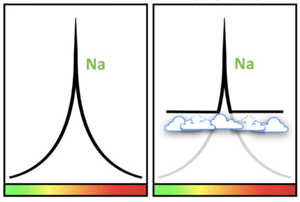
- このWASP-96bは、1,150光年離れた鳳凰座にあり、質量は木星の半分以下で、表面温度は538ºC以上もあり、公転周期は3.5日間である。これらの組み合わせによって、WASP96bは、大気調査の理想的な対象となっている。
- 6/21に、Webbの近赤外線撮影装置とスリットレス分光器は、恒星の前面を衛星が通過する際の減光を示す光曲線と赤外線波長(0.6-2.8μm)の明るさの減少を示すスペクトルを捉えた。その分析によって、水、霞、雲が存在したことは予想外であった。
- 注: 近赤外線(NIR) 1-3μm; 中赤外線(MIR) 3-40μm; 遠赤外線(FIR) 40-400μm
- WASP-39bは、恒星の前を通過する際に大気のスペクトルの撮影に成功し、水、SO2、CO、Na、K、および高い分解能でのCO2の検出に成功した。待機中のO2がCよりも豊富に存在していること示しており、WASP-39bは、本来は中心星から遠く離れた場所で形成されたこ可能性がある。(太陽系外惑星で光化学反応の具体的な証拠)
- Webb望遠鏡は、1/1000 μmの色の違いと、100万分の幾つかという明るさの変化を検出することができ、これらは、太陽系外惑星研究には、並外れた成果を示すことができる。
- 来年には、その分光計を利用して、岩石惑星から巨大惑星まで、観測時間の1/4を使った調査が行われる予定である。このようにWebbによって、生命の存在可能な世界を含めて、系外惑星の大気を驚くべき精度で分析できることは明らかである。
WASP-39b Atmosphere Update
- WASP-39b Atmosphere Update
- ASP-39b Atmosphere Update
Observations of WASP-39b with the JWST have revealed a detailed chemical composition of the exoplanet's atmosphere, including the first discovery of a photochemical reaction product.
- Scientists have identified the "mystery molecule" as sulfur dioxide, produced through photochemical reactions from light from the planet's host star, similarly to the formation of ozone in Earth's atmosphere.
- The findings indicated a history of smash-ups to the formation of ozone in Earth's atmosphere. The findings indicate a history of smash-ups and mergers of planetesimals, as well as evidence for patchy clouds in the atmosphere.
- The data from the four transits of WASP-39, gathered from three different instruments on JWST, provides a comprehensive view of the radiation process between the host star and the planet.
WASP-39bの大気組成
- WASP-39bの大気組成:
- WASP-39bの大気組成 (続き)
JWSTによるWASP-39bの観測により、太陽系外惑星の大気の詳細な化学組成が明らかになり、光化学反応による生成分が初めて発見された。
- この'謎の分子'は、地球大気のオゾン生成と同様に、惑星の主星からの光による光化学反応によって生成された二酸化イオウであると特定された。
- 今回の発見は、地球大気のオゾン形成と同様に、激しい衝突の歴史があることを示唆している。この発見は、準惑星の衝突と合体の歴史を示し、大気の中にパッチ状の雲がある証拠でもある。
- JWSTの3つの観測装置から得られたWASP-39の4回のトランジットデータは、主星と惑星との間の放射プロセスを包括的に理解することができる。
>Top 3. Vela: Southern Ring Planetary Nebula:
- Southern Ring Nebula (NGC 3132):
- For the first time, NASA's JWST has uncovered that the faint star at the core of this scene is covered in dust, following the release of gas and dust rings outwards for thousands of years. Webb's two cameras captured the newest image of NGC 3132, the Southern Ring Nebula, which is 2,500 lys away. The unseen before details of the two-star system in a tight orbit, seen in both Web's Near-Infrared Camera and Mid-Infrared Instrument. When viewed face-on, the Southern Ring Nebula appears as shown in this observation.
- However, if it were rotated to be viewed edge-on, its three-dimensional shape would be more obvious - two bowls placed at the base, facing away from one another and joined at the middle by a large opening.
- The brighter star, in an early stage of its evolution, is likely to cast off a planetary nebula eventually. In the left image from NIRCam, both stars can be seen, while the right image from MIRI reveals dust around the second star for the first time. As the two stars orbit one another, their brighter companion affects the appearance of the nebula, causing asymmetrical patterns due to their stirring of the gas and dust. This information allows astronomers to learn more about the mass-loss history of the stars, as well as how their orbits are affecting the environments of the nebula.
- The dust and molecules released by the stars can travel far billions of years and potentially become part of a new star or planet, before eventually dispersing into the nearby cosmos. Data collected with NIRCam show thin beams of light surrounding the planetary nebula. The starlight from the central stars is visible in places where the gas and dust have gaps, similar to how sunlight can be seen shining through clouds.
- Studying a planetary nebula is like viewing a movie in slow motion, as these phenomena are visible for tens of thousands of years. Each shell expelled by the star enables researches to examine the gas and dust within it in great detail.
3. 帆座の惑星状星雲 (NGC 3132):
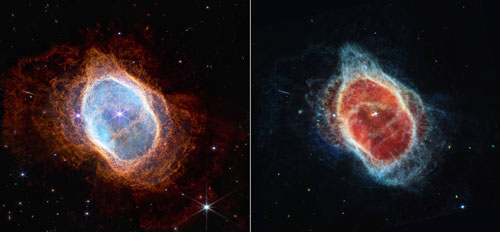
- 2,500光年離れたこの中心の赤色巨星が超新星にならず、何千年もガスとダストを放出した結果、外側のダストリングが形成し惑星上'星雲'と呼ばれるようになった。Webbの2台のカメラ(左はNIRCamと右はMIRI)は、NGC 3132の最新画像を捉えた。
- 右のMIRIの画像で、2番めの星の周りのダストが初めて明らかになった。進化の初期にある明るい伴星が、星雲の外観に影響を与え、非対称のパタンを引き起こした。(恒星の質量損失や恒星の軌道が星雲に与える影響がわかる)
- 星から放出されたダストや分子は何十億年もかけて遠方に飛ばされて新たな星や惑星の一部になるが、それが分散する前に、新たな星や惑星の一部になる可能性がある。NIRCamのデータによれば、惑星状星雲を取り囲む細い光のビームを示している。これらの雲間から太陽光が覗くように、ガスやダストの隙間から中心星の星明かりが見える。
- 惑星状星雲を研究することは、映画のスローモーションを見る如く、この現象は何万年も続く。星から放出された各殻を分析することで、その中のガスやダストを 詳細に調べることができる。
>Top 4. Pegasus: Stephan's Quintet:
- Pegasus: Stephan's Quintet:
- NASA's JWST captures Stephan's Quintet, a group of five galaxies, in a groundbreaking way. Webb's largest image to date, it covers 1/5th the area of the moon and consists of over 150,000,000 pixels and around 1,000 separate image files. Its infrared technology and high resolution offer unprecedented views of the galaxy, featuring sparkling star clusters, starbirth regions and gravitationally-induced tails of stars, gas, and dust. Impressive shockwaves from one of the galaxies, NGC 7318B, are revealed as it passes through the other galaxies. This provides insight into how galactic interactions may have driven early galaxy evolution.
- Édouard Stephan discovered Stephan's Quintet in 1877, located in the constellation Pegasus. Although referred to as a "quintet," only four of the galaxies are closely clustered together, with the fifth and leftmost galaxy, called NGC 7320, residing in the foreground. While NGC 7320 is located 40 million ly from Earth, the other four galaxies (NGC 7317, NGC 7318A, NGC 7318B, and NGC 7319) are almost 290 million ly away. This proximity provided astronomers the unique opportunity to study the merging and interactions between galaxies, processes fundamental to all galaxy evolution and rarely seen in so much detail.
- For example, star formation can be triggered in each other, and the gas in these galaxies can be disturbed. The topmost galaxy in the group -NGC 7319 - is home to an active galactic nucleus, a supermassive black hole 24 million times the mass of the Sun. Its light energy output equates to 40 billion Suns. To study this in greater depth, the Near-Infrared spectrograph (NIRSpec) and Mid-Infrared Instrument (MIRI) were employed, with the integral field units (IFUs) further providing scientists with a "data cube" of the galactic core's spectral features.
- Re: Data Cube: a schema optimized for analytical queries; arranging relevant information together, like storing sales of products at various locations over some period ot time, which enabled more flexible analysis identifying trends or evaluation each performance.
- Meanwhile, Webb was also able to resolved individual stars in NGC 7320, as well as its bright core, in addition to discovering a vast sea of distant background galaxies. Overall, the data collected by Webb can provide a wealth of valuable insight into the rate of which supermassive black holes feed and grow, star-forming regions, and emission from the dust. Together, the four galaxies of Stephan's Quintet make up Hickson Compact Group 92 (HCG 92), which serves as an ideal laboratory for exploring the cosmic dance of merging galaxies.
4. ペガスス座: ステファンの五つ子:
- ステファンの五つ子銀河 (ペガスス座)
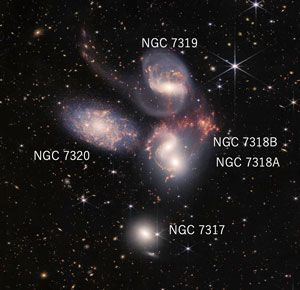
- ペガスス座の方向にあるNGC7320だけは40M光年先に、他の4銀河は290M光年先にある。
- 1877年でÉdouard Stephanが、マルセイユ天文台でコンパクト銀河群である五つ子銀河を発見した。
- 最も明るいNGC 7320は、広いHII領域を持ち、活発な星形成が行われている。
- 4つの銀河の近接性は、銀河間の合体と相互作用を検討する格好のテーマとなる。
- NGC 7313Bは、時速数百mileの速度で銀河群の中心に落ち込んで衝撃波を発生させている。この衝撃波中にH2分子の赤外線放射が観測されている。
- NGC7319の中心には、太陽の2400万倍の質量をもつブラックホールがあり、その光エネルギーは太陽の400億個に相当する。
- Re: データキューブ: 多次元のデータ(複数のdimensionと、集計(aggregation)対象の値であるmeasureの組合わせ)を様々な観点から分析する多次元データベース
- 4つの銀河群は、重力的に連結してHCG 92を構成し、これらの合体を通じて超巨大ブラックホールの正当速度、星形成領域、ダストの放出などが観測できる。
>Top 5. Carina: Cosmic Cliffs in the Carina Nebula:
- Cosmic Cliffs in the Carina Nebula
- Using NASA's new JWST, infrared light has been captured to uncover previously invisible areas of star birth in a young, star-forming region called NGC 3324 in the Carina Nebula. Appearing as a landscape of craggy "mountains" and "valleys" speckled with stars, this region is known as the Cosmic Cliffs and the tallest peaks in the image are around 7 ly high. The blistering, ultraviolet radiation from the young stars is eroding away the nebula's wall and creating dramatic pillars above the glowing gas.
- Additionally, hot gas and dust stream away from the region due to the relentless radiation, giving the appearance of "steam" rising from the celestial "mountains". Webb is able to capture protostellar jets and individual stars completely hidden in visible-light pictures, as well as address questions that have been difficult to answer when studying star formation.
- The data acquired from NGC 3324 will help us to understand what sparks star formation, what limits it, and the effect of star formation on giant clouds of gas and dust. Located roughly 7,600 ly away, NGC 3324 was catalogued in 1826 by James Dunlop and resides in the constellation Carina. The Carina Nebula, which is where NGC 3324 can be found, contains the Keyhole Nebula and the active, unstable supergiant star, Eta Carinae.
5. 竜骨座: 宇宙の崖(NGC3324):
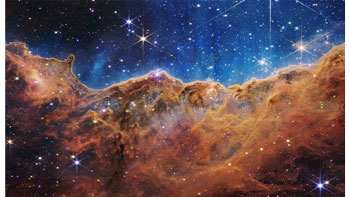
- 険しい山と谷の風景にも見える領域は、'宇宙の崖'と呼ばれ、高さは7 光年ある。若い星からの猛烈な紫外線が星雲の壁を侵食し、輝くガスの上に劇的な柱を作り出している。
- さらに、放射線により高温のガスとダストが流れ去り、山から蒸気が立ち上っているように見える。
- NGC 3324から得られたデータは、何が星形成を引き起こし、あるいは制限し、ガスとダストの巨大な雲に対して星の形成の影響を理解するのに役立つ。これらは7,600光年離れており、1826年にJamese DunlopがNGC 3324として登録した。それが属する竜骨座星雲には、キーホール星雲と不安定な超巨星イータ・カリーナ(η Car) が含まれる。
- η Carinaeは、太陽質量M⦿の100倍以上もある極超新星(hypernova); しかも連星)と見られる。過去に放出された物質が星雲(人形星雲)となって周囲を取り囲んでいる。
>Top 6. Jupiter and its moon Europa:
- Jupiter and its moon Europa
- NASA's JWST has provided stunning new views of Jupiter, including a look at its iconic Great Red Spot and the surrounding moons, revealing details of our Solar System in infrared vision.
- The telescope's NIRCam instrument captured distinct bands encircling the planet, as well as the vast storm, appearing white due to the processing of the image. The startlingly clear image captured moons such as Europa, Thebe and Metis - the latter two of which can been seen to the left of the Great Red Spot - and even minor details like hazes and Jupiter's thin rings, making the results a pleasant surprise to scientists.
- Bryan Holler of the Space Telescope Science Institute noted, "From the faintest, most distant observable galaxies to planets in our own cosmic backyard, the JWST has the full grasp of what it can observe." The telescope's infrared capabilities provide a unique opportunity to monitor moons like Europa and Saturn's Enceladus for possible plumes spewing material, as well as giving scientists a never-before-seen view of Jupiter's rings.
- According to Stefanie Milam, Webb's deputy project scientist at NASA Goddard Space Flight Center, "It's really exiting to think of the capability and opportunity that we have for observing these kinds of objects in our solar system."
6. 木星とその衛星 Europa:
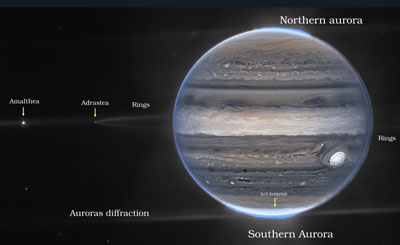
- JWSTによる木星の新たなビュー; 象徴的な大赤斑(Great Red Spot)と衛星 (Europa, Thebe & Metis 最内側軌道)
- JWSTの赤外線装置によって、太陽系の惑星やその衛星から物質を噴出するプルームの観察など新たな画像情報がもたらされることが期待される。
Jupiter and its auroras
- Jupiter and its auroras:
- To make the infrared light visible to the human eye, it has been mapped onto the visible spectrum, with redder colors representing the longest wavelengths and bluer colors representing the shortest wavelengths. Scientists and citizen scientist Judy Schmidt transformed the data from the observatory into the images.
- The standalone view of Jupiter highlights the auroras in the reddest filter, and depicts the hazes swirling around the poles in yellows and greens, as well as light from a deeper main cloud in blues. Scientists have discovered that the Great Red Spot and equatorial region of Jupiter have high altitude hazes, while the north of the equator has dark ribbons with little cloud cover. The white spots and streaks are likely the tops of convective storms condensed in the high altitude clouds.
- It is difficult to combine images of Jupiter into a single view due to tis rapid rotation. Scientists must make digital adjustments to stack the images in order for them to make sense.
木星のオーロラ:
- 木星のオーロラ:
- 木星のオーロラは、太陽系も最も強烈で、明るさは地球のそれの約1000倍。
- 衛星イオの活発な火山活動によってプラズマ化した溶岩が放出され、木星の強力な磁場に取り込まれ両極に集中する。そこで電荷を帯びた粒子が木星大気と反応してオーロラが発生する。
- 木星の大赤斑と赤道地域には高高度の霞があり、赤道の北には雲がほとんどない暗いリボンがある。白い斑点と縞模様は、高高度の雲に凝集された対流嵐の上部と思われる。
- 木星は自転が速いので、一枚の画像に結合することは困難だが、デジタル調整によって1枚の画像に重ね合わせた。
>Top 7. Ursa Major: The Oldest Galaxy GLASS-z11 and GLASS-z13:
- GLASS-z11 and GLASS-z13,
- The two candidates for the most distant known galaxies
Using the JWST, astronomers examined the gigantic Abell 2744 galaxy cluster, which was acting a gravitational lens to distort an image of more remote galaxies. Rohan Naidu's team from the Harvard-Smithsonian Center for Astrophysics identified two galaxies - GLASS-z11 and GLASS-z13 - from initial data from the Grism Lens-Amplified Survey form Space (GLASS).
- The galaxies have a redshift of 11 and 13 respectively, which indicates that they existed about 13.4 billion years ago, approximately 400 million and 300 million years after the Big Bang. Though the redshifts were determined from the Near Infrared Camera (NIRCam), a more detailed spectrum analysis employing the Near Infrared Spectrograph (NIRSpec) will be necessary to confirm them.
- To the astronomers' surprise, the two galaxies were found in a 50-square-arcminutes area of the sky. This abundance of luminous galaxies in the early universe signifies that they are more frequent than previously assumed. GLASS-z11 and GLASS-z13 are moderately small galaxies today, measuring between 3,000 to 4,500 ly across and containing around a billion stars each.
- Nevertheless, they are large for their time. Additionally, the two galaxies display a spiral disk-like structure, a phenomenon which contradicts the usual clumpy structure of high-redshift galaxies. Based on galaies formation theory, GLASS-z11 and GLASS-z13 have presumably increased in size and become giant elliptical galaxies over the past 13.4 billion years, and presently lie about 32 billion ly from us - too far for any telescope to observe.
7. 大熊座: 最古の銀河 GLASS -z11/z13:
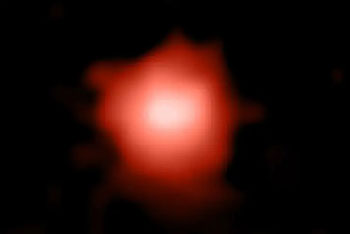
- 最古の銀河候補の発見: パンドラ銀河団 Abell 2744を調査。この銀河団は、重力レンズとして作用し、より遠くの銀河の画像を歪めている。
- Harverd-Smithsonian天体物理学位センターのチムは、Grism Lens-Amplified Survey form Space (GLASS) のデータから134億年前の2つの銀河 (それぞれBig Bang後3億年と4.5億年後に形成)を特定した。
- この2つの銀河は、空の50平方分角の領域で発見された。これは、初期宇宙では銀河が豊富でったことを示している。2つの銀河は、過去134億年の間におそらくサイズが増大した巨大な楕円銀河となって、約320億光年離れている。
>Top 8. Phantom Galaxy M74:
- NGC 628 (the "Phantom Galaxy")
- A stunning image from the JWST shows the intricate details of the phantom Galaxy (M74) located in the constellation Pisces. Noted for its grand design spiral structure, M74 lies almost face-on to Earth, allowing Webb to observe its gas and dust filaments in the spiral arms that extend outward from its nucleus. The absence of gas in its core gives a clear view of its nuclear star cluster.
- By studying the star formation of this galaxy located 32 million ly away, the PHANGS (Physics at High Angular resolution in Nearby GalaxieS) collaboration is using Webb's mid-infrared vision together with Hubble's ultraviolet and visible capabilities as well as radio images from the Atacama Large Millimeter/submillimeter Array, ALMA, to gain a deeper understanding of M74. The thorough combination of data from a variety of telescopes across the electromagnetic spectrum provide astronomers with even more insight than Webb alone can generate.
8. うお座: 渦巻銀河 (M74) :
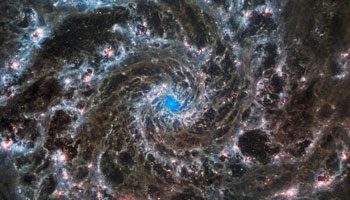
- うお座にある地球に対し正面を向いた見事な渦巻き銀河。そのコアから外側に伸びる渦巻状の腕の中にあるガスとダストが見える (JWST MIRI)
- PHANGS (近傍銀河高分解能物理学) は共同研究組織。Webbの赤外線画像のみならず、Hubbleの紫外線・可視光に電波望遠鏡のミリ波・サブミリ波のデータを組み合わせた研究成果。この銀河は32M光年離れている。
>Top 9. Sculptor: Cartwheel galaxy (ESO 350-40 or pGC 2248):
- Odd Cartwheel galaxy
- Odd Cartwheel galaxy in a unprecedented detail
NASA's JWST has used its powerful infrared capabilities to uncover new details of the Cartwheel Galaxy. This rare cosmic sight, located 500 million ly away, is the result of collision between two galaxies. The image features two rings that expand outwards, like ripples in a pond, and reveals a vibrant star fromation in the galaxy's outer ring.
- Webb's Near-Infrared Camera uncovers many individual stars, as well as the difference between the smooth distribution of the older star populations and the clumpy shapes associated with the younger stars. The image paints a vivid new picture of how the Cartwheel Galaxy has changed over billions of years.
- Using MIRI data that appear red in the composite image, Webb sheds light on the finer details of the dust in the Cartwheel Galaxy. This image shows various hydrocarbons, chemical compounds, and silicate dust, similar to that found on Earth, present in the form of a series of spiraling spokes.
- Previous Hubble observations were able to detect the spokes in 2018, but the Webb image reveals them with much more clarity. Through this observation, it is clear that the Cartwheel is evolving, as it was once a normal spiral galaxy like the Milky Way before its collision This image helps us understand the past and predict the future of the galaxy.
9. 彫刻室座の車輪銀河 (ESO 350-40):
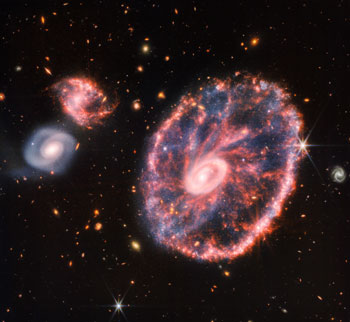
- 約5億光年に位置する車輪銀河は、小さな銀河が大きな渦巻き銀河に衝突した結果、車輪のような姿になった。今回JWSTのNIRCamとMIRIにデータ分析による画僧では、外側のリングに周囲のガスがぶつかることで星形成が促進されている様子が鮮明になった。銀河内のダストには炭化水素や珪酸塩が大量に存在している。
- 外側のリングは4.4億年の間広がり続けている。特にスポーク構造のダストは、ほとんどがシリカのダストからなる。
>Top 10. Boötes: Pair Galaxy VV191:
- James Webb (NIR) + Hubble (Optical) combined picture of pair of galaxies
- Researchers were able to trace light emitted by the large elliptical galaxy on the left through the spiral galaxy on the right, thanks to the combination of data from the NASA/ESA/CSA Hubble Space Telescope. This picture of VV 191 includes near-infrared light from the Webb, and ultraviolet and visible light from Hubble, and it allowed the researchers to scrutinize the effects of interstellar dust in the spiral galaxy.
- By observing Webb's near-infrared data, we can observe the extended, dusty spiral arms of the galaxy in greater detail, giving the impression that they are overlapping with the central bulge of the bright white elliptical galaxy on the left. Even though the two galaxies are relatively close astoronomically, there is no indication of them interacting.
- Pay attention to the backdrop! Just like other photographs taken by Webb, this image of VV 191 reveals multiple galaxies located millions of ly away. For instance, two fuzzy spiral galaxies can be seen on the upper left side of the ellipsoid galaxy, appearing to have roughly the same size but showing distinct hues. It's hypothesized that one could be immersed in dust while the other is distant, though experts still need to acquire spectra to ascertain which one is which.
10. うしかい座: ペア銀河 VV191:
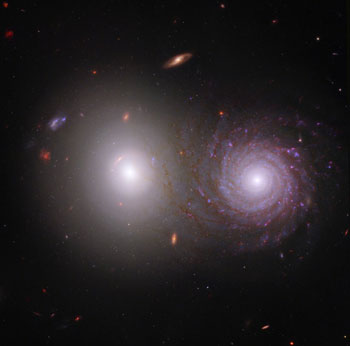
- うしかい座にあるペア銀河(VV191)。KWSTの近赤外線とHubbleの可視光と紫外線の合成画像。
- 右側の渦巻銀河 (Spiral galaxy)からの渦状腕が左側の楕円銀河 (Elliptical galaxy)にかかっているように見えるが、相互作用はしていない。
- 渦巻銀河を通過してきた楕円銀河の光を分析することで渦巻き銀河の星間ダストの影響を特定できる。
- また楕円銀河の10時の方向に重力レンズを受けた弧状の銀河が写っている。
>Top 11. Sygnus: Wolf-Rayet star of Binary SBC9 1232:
- Star WR 140
- Star WR 140 surrounded by strange concentric shells
In July, the highly anticipated JWST captured an awe-inspiring image of a distant Wolf-Rayet star, WR140, that had mysterious concentric rings radiating outward. Shared on Twitter by citizen scientist Judy Schmidt, the image sparked a flurry of comments and debate about the origin of these intriguing patterns.
- Mark McCaughrean of the JWST Science Working Group explored the possibility that this phenomenon was due to the star's companion star sculpting dust into an odd, yet regular shape. Ryan Lau, the Principal Investigator of the project, has since submitted a paper that is soon to be released, exploring more on this topic, Despite the bewilderment of the image, it serves as a reminder of the power of the $10 billion JWST, the most powerful observatory sent to space to date, which is renowned for its unique infrared vision.
11. 白鳥座: 連星 SBC9 1232のWolf-Rsyet星:
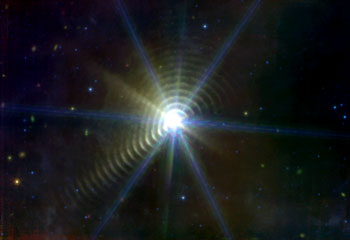 白鳥座のDeneb, γ Cygni、δ SCygniの三角形の中心5,300光年に位置する連星系Wolf-Rayet 140 (太陽質量M⦿の25倍以上の高温星O型星)を、JWSTのMIRIで観測した結果、少なくとも17本のダストのリングが同心円上に連星をシェル状に取り巻いている様子が得られた。
白鳥座のDeneb, γ Cygni、δ SCygniの三角形の中心5,300光年に位置する連星系Wolf-Rayet 140 (太陽質量M⦿の25倍以上の高温星O型星)を、JWSTのMIRIで観測した結果、少なくとも17本のダストのリングが同心円上に連星をシェル状に取り巻いている様子が得られた。- このリングは、連星の軌道周期約’8年毎に、双方の星から吹き出した恒星風が正徳することもダストのリングが生成される。(超新星爆発の前に多くの炭素を含み有機物を含むダストを生み出す活動と見られる)
>Top 12. Aquila: The Pillars of Creation:
- The Pillars of Creation
- The Pillars of Creation
The iconic Pillars of Creation can be seen in a highly detailed and vibrant landscape captured by NASA's JWST. These columns of cool interstellar gas and dust, often semi-transparent in near-infrared light, are the perfect setting for new stars to form. By precisely counting the young stars that have burst out of the dense gas and dust clouds, researchers are able to investigate the processes of star formation over millions of years.
- These stars, represented by the bright red orbs with diffraction spikes, produced supersonic jets and shocks that create glowing hydrogen molecules and wavy patterns, visible at the edges of some pillars.
- Much of the deeper universe is hidden behind the interstellar medium, a mix of gas and dust in the densest part of the Milky Way galaxy's disk.
- The scene revisited by Hubble in 1995 and 2014, as well as other advanced observatories, reveals more details about this star-filled region 6,500 ly away in the Eagle Nebula.
12. 鷲座: 星雲 '創造の柱':
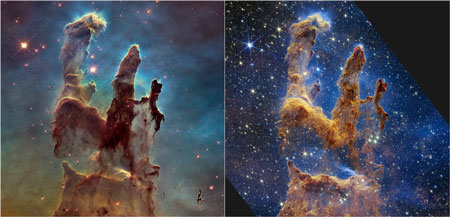
- 上右はJWSTのNIRCamによる画像で、柱のように見える部分はガスとダストが集積した分子雲で、数百万年にわたり新たな星が形成されている。
- 明るい星からの放射状の光は回折スパイク ( deffraction spike)が超音速のジェットとして水素分子と波状のパターンを形成している。
- 深宇宙の多くは、星間物質によって隠されている。
- この領域は、1995/2014にハッブル望遠鏡で観測している(左図)6,500光年先にある鷲座星雲にある。
>Top 13. Microscopium: Red Dwarf AU Mic:
- Planet forming disk of dust surrounding a small young star AU MIC
- Observing the red dwarf star AU Microscopii (or AU Mic) in the constellation Microscopium, located 32 light-ears away, NASA's JWST has provided a glimpse back into the history of the system. With Webb's highly-sensitive and powerful infrared instruments, the study's lead author Kellen Lawson of NASA's Goddard Space Flight Center in Maryland was able to directly observe a large and extremely dusty debris disk surrounding AU Mic.
- This disk is a remnant of the formation of AU Mic, likely containing planetesimals, the leftovers of the formation of planets, her team observed at wavelengths of 3.56 and 4.44 microns. The images of the system, approximately 23 million years old have a blue appearance due to the high amount of fine dust that scatters light at shorter wavelengths.
- Moreover, the use of Webb's Near-Infrared Camera and coronagraph allowed them to trace the disk to within five astronomical units of the star. The study's primary goal is to search and characterize gas-giant exoplanets in wide orbits and their results have made it possible to directly observe these exoplanets around their host star.
13. けんびきょう座: 赤色矮星 AU Mic:
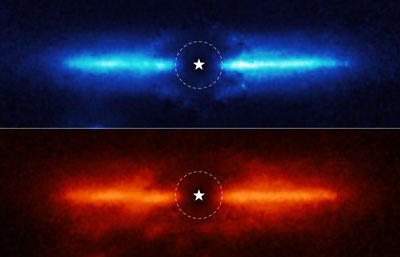
- JWSTのNIRCamによって、顕微鏡座(Microscopium)方向の32光年先にある若い (23M年)の赤色矮星を取り囲むダスト円盤(dusty debris disk)を3.56μmと4.44μmの波長で撮影した。ダスト円盤は、短波長に対してより明るい見えるのは、短波長に対してより散乱する (青色に)からである。これは重量星と異なりAu MIcからの放射圧が強くないので細かなダストが飛ばされないためと見られる。
- なお、この星には2つの惑星が発見されている。(中心星の光は、ブロックして撮影)
- この体系は若い恒星のダスト円盤が、恒星から5AUまでの近接観測された数少ない事例である。この円盤はAU Mic形成時の残骸で、形成時の準惑星を含んでいる可能性が高いという。
>Top 14. Nature Astronomy (4 April 2023):
- Two papers published today in Nature Astronomy present the discovery of four of the most distant galaxies yet found. The observations were made with the NASA James Webb Space Telescope (JWST), which launched on Christmas Day 2021. JWST is a bigger telescope than the Hubble Space Telescope, and can work at longer wavelengths, which makes it an ideal machine for finding very distant galaxies, which are faint and also highly redshifted by the expansion of the Universe.
- The work was done by the teams which built two of the key instruments for JWST – the near-infrared camera (NIRCam) and the NIRSpec spectrograph. NIRSpec is a European Space Agency contribution to JWST, and its instrument science team is based across six leading European universities, including the University of Oxford.
14. Nature Astronomy誌 (4 Apri 2023):
- 今日(4/4/2023) Nature Astronomy に掲載された 2 論文は、これまでに発見された中で最も遠い銀河の内の 4つを発見したことが書かれている。これは、2021 年のクリスマスに打ち上げられた NASA James Webb宇宙望遠鏡 (JWST) で観測された。ました。JWST は、ハッブル宇宙望遠鏡よりも大きな望遠鏡で、より長い波長で観測できるので、非常に遠方の銀河を見つけるのに最適の望遠鏡である。 これらの銀河の光はかすかで、また宇宙の膨張によって極端に赤方偏移している。
- この作業は、JWST の 2 つの主要な機器である近赤外線のカメラ (NIRCam) と分光器( NIRSpec)を構築したチームによって実施された。 分光器は、JWST に対する欧州宇宙機関の貢献であり、その機器観測科学チームは、オックスフォード大学を含む 6 つの主要なヨーロッパの大学が協力している。
>Top 15. AU MIC:
15. xxxx:
>Top 16. xxxx:
-
16. xxxx:
Comment
- In these days, there are lots of pessimistic news such as still ongoing wars, coronary infections; but the new discovery by JWST is exceptionally positive and exciting news for us.
- 戦争とコロナ禍と経済不況の暗いニュースが続く世界の中でJWSTによる新発見は、我々をわくわくさせる明るいニュースである。
James Webb's Amazing Discoveries
|
Cat: SCI |
|
Insane Curiosity 2023/03/01 |
23417u |
Python Sympy Code |
Remarks |
>Top 0. Introduction:
|
0. 序文:
|
>Top 1. Volans: Galaxy Cluster SMACS 0723:
|
1. とびうお座: SMACS 0723銀河団:
|
Two Arcs Are the Same Galaxy
|
2つのアークは同じ銀河:
|
>Top 2. Phoenix: Exoplanet WASP-96b:
|
2. 鳳凰座: 太陽系外惑星 WASP-96b:
|
WASP-39b Atmosphere Update
|
WASP-39bの大気組成
|
>Top 3. Vela: Southern Ring Planetary Nebula:
|
3. 帆座の惑星状星雲 (NGC 3132):
|
>Top 4. Pegasus: Stephan's Quintet:
|
4. ペガスス座: ステファンの五つ子:
|
>Top 5. Carina: Cosmic Cliffs in the Carina Nebula:
|
5. 竜骨座: 宇宙の崖(NGC3324):
|
>Top 6. Jupiter and its moon Europa:
|
6. 木星とその衛星 Europa:
|
Jupiter and its auroras
|
木星のオーロラ:
|
>Top 7. Ursa Major: The Oldest Galaxy GLASS-z11 and GLASS-z13:
|
7. 大熊座: 最古の銀河 GLASS -z11/z13:
|
>Top 8. Phantom Galaxy M74:
|
8. うお座: 渦巻銀河 (M74) :
|
>Top 9. Sculptor: Cartwheel galaxy (ESO 350-40 or pGC 2248):
|
9. 彫刻室座の車輪銀河 (ESO 350-40):
|
>Top 10. Boötes: Pair Galaxy VV191:
|
10. うしかい座: ペア銀河 VV191:
|
>Top 11. Sygnus: Wolf-Rayet star of Binary SBC9 1232:
|
11. 白鳥座: 連星 SBC9 1232のWolf-Rsyet星:
|
>Top 12. Aquila: The Pillars of Creation:
|
12. 鷲座: 星雲 '創造の柱':
|
>Top 13. Microscopium: Red Dwarf AU Mic:
|
13. けんびきょう座: 赤色矮星 AU Mic:
|
>Top 14. Nature Astronomy (4 April 2023):
|
14. Nature Astronomy誌 (4 Apri 2023):
|
>Top 15. AU MIC: |
15. xxxx: |
>Top 16. xxxx: |
16. xxxx: |
Comment |
|
|